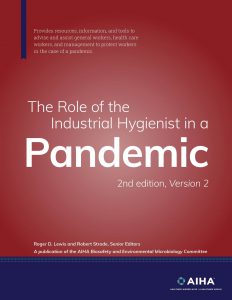The Role of the Industrial Hygienist in a Pandemic: A roadmap for COVID-19 and beyond
Posted on by Since the beginning of the COVID-19 pandemic, the National Institute for Occupational Safety and health (NIOSH) and the American Industrial Hygiene Association (AIHA) have been developing guidance to help protect workers across all industries. AIHA has more than 80 years of experience protecting the health and safety of workers and their communities and has been at the forefront of efforts to prevent and control the spread of COVID-19. Early in the COVID-19 response effort, NIOSH established a cooperative agreement with AIHA to increase the national capacity for occupational technical assistance to employers, workers, and public health officials for workplaces.
Since the beginning of the COVID-19 pandemic, the National Institute for Occupational Safety and health (NIOSH) and the American Industrial Hygiene Association (AIHA) have been developing guidance to help protect workers across all industries. AIHA has more than 80 years of experience protecting the health and safety of workers and their communities and has been at the forefront of efforts to prevent and control the spread of COVID-19. Early in the COVID-19 response effort, NIOSH established a cooperative agreement with AIHA to increase the national capacity for occupational technical assistance to employers, workers, and public health officials for workplaces.
As part of the cooperative agreement, AIHA updated the guidance document, “The Role of the Industrial Hygienist in a Pandemic.” It was originally published in 2006 by the AIHA Biosafety and Environmental Microbiology Committee to address the then-recent SARS-CoV-1 outbreak. AIHA originally based the guidance on possibilities and assumptions about preparing for pandemics. The new edition incorporates real-world lessons from the H5N1 avian flu, the H1N1 swine flu, and the SARS-COV-2 pandemics. It also includes new information and resources and connects pandemic response strategies to the NIOSH-supported Total Exposure Health and Total Worker Health® frameworks. In addition to providing funding support via the cooperative agreement, NIOSH reviewed the content to ensure it aligned with current CDC guidance and research.
What’s New in the Second Edition?
The second edition provides significant new information on inhalation and airborne pathways and controls and provides a glossary of terms and definitions. Many of the original sections have also been expanded, particularly those focusing on controls. For example, the section on exposure assessment introduces the source-pathway-receptor paradigm. This paradigm is an alternative framework for controlling infectious disease transmission to the standard hierarchy of controls.
Other updated sections cover
- control and exposure banding
- sensor technology and instruments
- analytics and tracking
- shutdown and reopening
- special considerations for workers with pre-existing conditions and industries with unique challenges.
Each major section also includes lessons learned, where examples of related experiences and information gained during the past and current pandemics are described.
Who should use the guide?
Although the primary audience is industrial hygienists, the guide can also be useful to other occupational, environmental health and safety (OEHS) professions, such as healthcare workers and infection preventionists, and non-OEHS professionals, like architects, mechanical engineers, and ventilation specialists. These other, non-industrial hygienists should be able to apply aspects of the information provided in the guide to their individual practices and workplaces. For example, the pathway controls section can be useful to any professional involved with designing, building, or modifying existing architectural and mechanical systems to control how infectious agents are transmitted.
Download the second edition of “The Role of the Industrial Hygienist in a Pandemic” for free on AIHA’s website.
Before you leave this page, we’d love to hear from you! Comment below to let us know what you think of the new edition. What other lessons have you learned to protect workers in the pandemic that might be useful now and in the future? What areas of the 2nd edition have you found useful? How could we improve this guide based on your experiences? Please leave your thoughts in the comments below.
Roger D. Lewis, PhD, CIH, a professor emeritus of environmental and occupational health at Saint Louis University College of Public Health and Social Justice.
Robert D. Strode, MS, CIH is an associate scientist at Chemistry & Industrial Hygiene, Inc.
Ina Xhani is a communications specialist with AIHA.
Kevin H. Dunn, Sc.D., CIH, is research mechanical engineer with the NIOSH Division of Field Studies and Engineering.
Eric Glassford, MS, CIH is an industrial hygienist with the NIOSH Division of Field Studies and Engineering.
Jennifer Tyrawski, PhD, is a health communications specialist in the NIOSH Division of Field Studies and Engineering.
Posted on by

